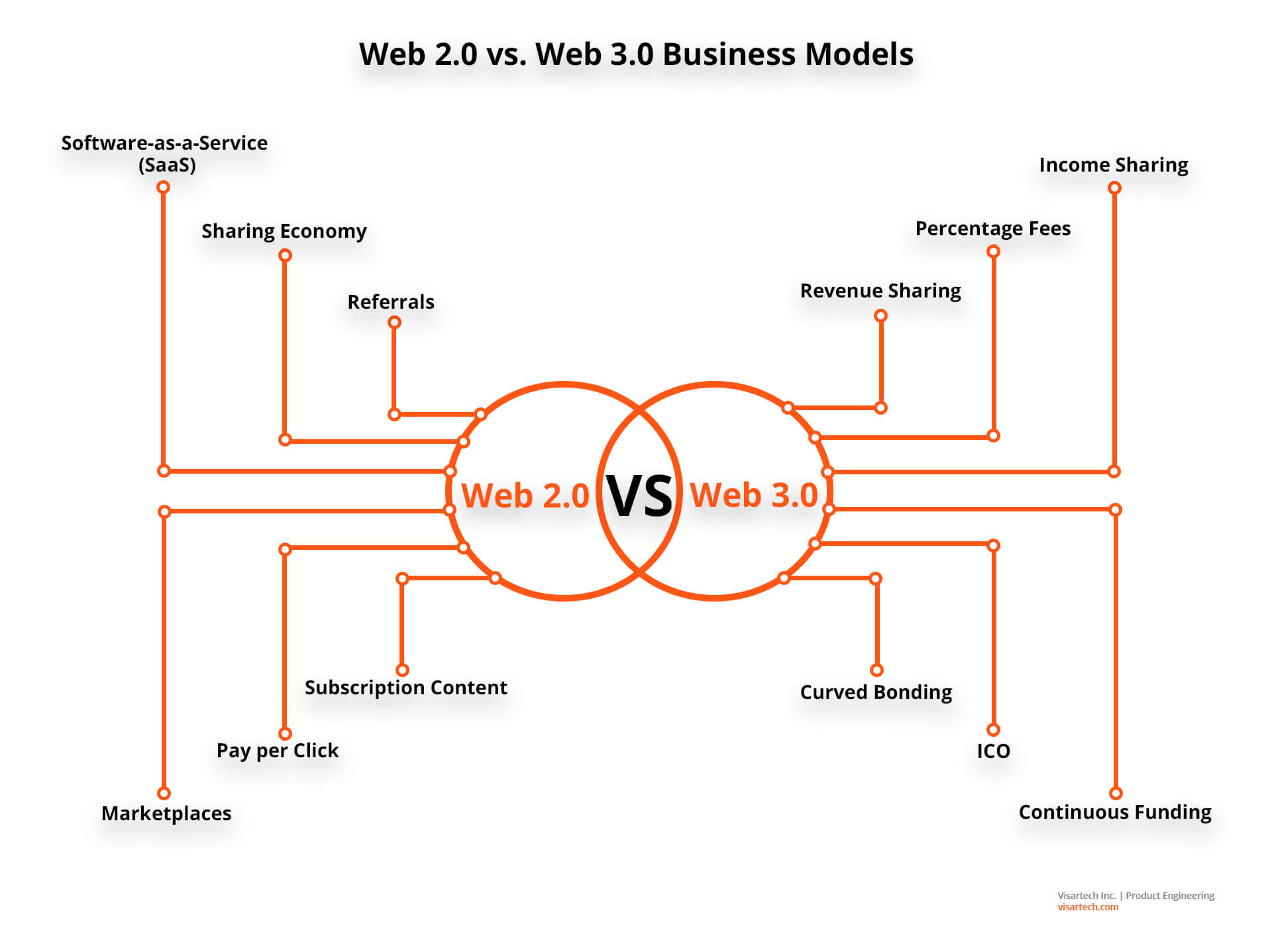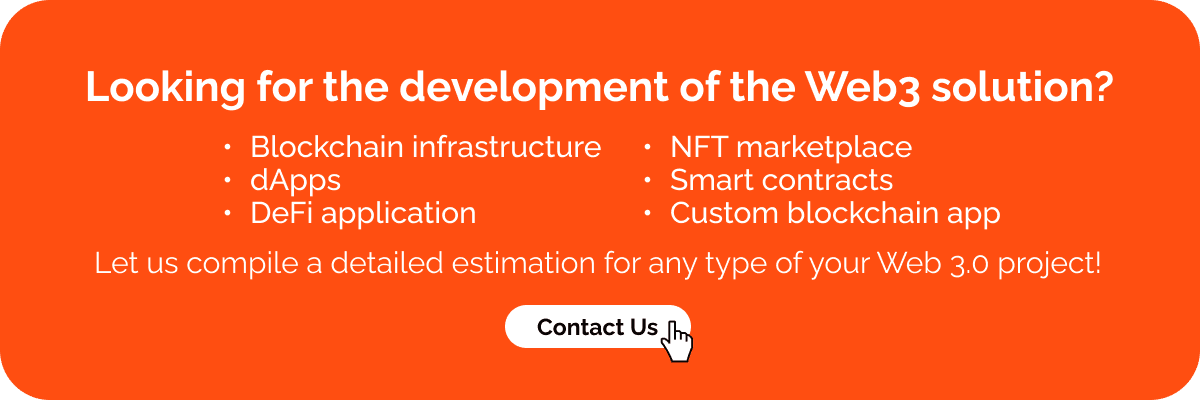The advent of Web 3.0 or Web3 development is bringing massive challenges and revolutionizing the ways organizations are doing business. In this article, we will answer a question “What is Web3?”, and explore the most vivid Web 3.0 business models and technologies that companies may leverage to harness Internet 3.0 potential.
What is Web 1.0, Web 2.0, and Web 3.0?
With technologies developing at a head-spinning pace, it seems it only took one blink of an eye for the Internet to grow into what it is now.

Yet, from the 1990s forward the transformation of the world wide web has gone through several distinct stages.
- Web 1.0
During the phase that lasted from the 1990s to the 2000s, the internet mainly featured static pages. Users couldn’t voice their feedback or opinions on them.
- Web 2.0
This version of the web started in the 2000s and continues even now. It is also called a social web, with users playing a key role in information exchange. This is the era of Facebook, Twitter, and YouTube when most of the content posted or shared relies on users’ contributions.
- Web 3.0
The new era is shaping up right in front of our eyes. This is the phase when computers can understand and interpret information, and deliver personalized content. The web itself is built around decentralized technologies.
The Key Features of Web 3.0
Compared to its predecessors, Web 3.0 is more powerful and user-centric. Undoubtedly, it is more technologically advanced.

The feature that Web3 relies on include:
Semantic Web
Web 3.0 contains tools and technologies allowing computers to understand and interpret information similarly to humans. One of the core concepts of the Semantic Web is metadata. These are attributes and descriptors added to existing information and content. They help machines to process it and pull meaningful insights.
Artificial Intelligence (AI)
Infused into every app, technology, or process, AI is one of the key components of Web3. Enabling computers to mimic how humans perceive and process data, AI is widely used in modern web-based apps and services.
3D Interactive Web
In the brand-new web world, 3D graphics and immersive experiences are entwined into browsing experiences. In fact, technologies like WebGL are a major part of modern digital web design. Users can turn, spin, zoom in, and otherwise manipulate graphics. It takes activities like gaming, studying, and internet shopping to an entirely new level.
Ubiquity
Web 3.0 is ubiquitous, meaning you can access it from anywhere. Internet access relies on laptop and smartphone connectivity as well as on web-connected IoT sensors.
The Social Web
Inherited from Web 2.0, this feature refers to a user-centric network, which urges users to share and generate content. It also provides an option to leave feedback.
Decentralized Technology
Finally, Web 3.0 uses decentralized technology requiring no controlling nodes to operate. It’s way more sophisticated than old-school web page development. The building blocks of decentralized technology include:
- Blockchain. A distributed ledger uses numerous nodes so that the information cannot be deleted.
- Smart contracts. Contracts are executed automatically upon fulfillment of certain conditions.
- NFTs. Non-fungible tokens are digital representations of assets containing information about ownership rights.
If we had to provide Web3 meaning in three words, that would be decentralization, personalization, and omnipresence. In the next section, we are going to discuss the examples of Web 3.0 benefits for businesses.
Why Should Businesses Embrace Web3 Development?
Keeping abreast of the rising trends is beneficial for every company. However, the advantages of doing business on the web using Web 3.0 deserve a detailed description.

Below are the most impactful innovations that Web3 brings to the table:
- Data ownership and control
Web 3.0 will eventually enable users to take full control of their data. From a business perspective, this will rid businesses of the need to adhere to burdensome regulatory requirements, since users will have full data ownership. It will also be up to clients to decide which part of their personal data they are ready to share.
- Interoperability
This spells good news to anyone familiar with web application development. Web 3.0 tools will run on all devices or platforms, so cross-platform availability will no longer be an issue.
- Permissionless blockchain
With no central authority, there is no bias and discrimination, so anyone can join the network and be its participant. For businesses, this may quickly, reliably, and painlessly transfer digital assets across borders.
- Anti-monopoly
Since users will have full control over their data, the monopoly of tech giants will be broken. That, in turn, will create a more transparent market based on fair principles.
However, the adoption of Web 3.0 will require companies to rethink their business models and adapt to generating revenue in a different way.
Web2 vs. Web3: What Is the Difference?
From 2010 forward, the main business model of Web 2.0 revolved mostly around the collection and monetization of users’ data. Big market players are aggregating users around their apps and services and profiting from showing them targeted ads.

Other popular business models of Web2 world are:
- Software-as-a-Service (SaaS)
Create a web app and sell annual or monthly subscriptions to its services – this is how the SaaS model works in a nutshell. Consider creating a web application available on a freemium basis. Meaning basic functionality will come free of charge while accessing more advanced features will require regular payment.
- Marketplaces
Web 2.0 is an era of marketplaces – web-based platforms connecting clients to companies/individuals selling products or rendering services. For example, the best-known eLearning marketplaces are Udemy and Coursera. Another example is Upwork – a freelancing marketplace connecting companies and workers.
Apart from the ones mentioned above, there’re many more Web 2.0 business models such as:
- Sharing Economy
A nontraditional way of e-commerce business entails shifting to more collaborative sharing of resources. The exchange of value can take place through a marketplace, a collaboration platform, or a peer-to-peer program.
- Referrals
Attracting new customers through recommendations and word of mouth. Usually, these actions involve a reward for each new customer.
- Subscription Content
The goal is to sell products or services using a recurring payment system. The main focus of this model is not on attracting new customers, but on retaining existing ones.
- Pay per Click
The online advertising model, where an advertiser pays for each clicked link in the ad. Mainly this model is offered by search engines (such as Google) and social networks (Facebook, Twitter, and so on).
By contrast, the online business models of the Web 3.0 blockchain world will include:
- Revenue sharing
Splitting earnings between all the participants of a business venture encourages them to further innovate and build new solutions.
- Percentage fees
A marketplace, for example, may charge a small fee for every transaction performed on the platform.
- Income sharing
Within the income-sharing model, revenue is distributed between all the value chain participants.
- ICO’s
The term ICO stands for initial coin offerings. A company may sell its coin or currency to raise funds.
- Continuous funding
Web3 companies also leverage a continuous funding revenue model. Rather than selling tokens all at once, this model presupposes selling them continuously over time.
- Curved bonding
This model distributes the price of tokens across the value growth of an asset. When the value increases, so do the token price. This model gives people an incentive to invest in advance before the token gets expensive.
Describing all of the possible Web 3.0 business models falls far beyond the scope of this article. Online businesses of the not-so-distant future will be leveraging the decentralized autonomous organizational model (DAO) which involves collective responsibility and leadership.
Let’s now move on to explore how this new evolving web works.
Top 8 Web3 Use Cases
The shift towards Web3 is already underway. It is noticeable because of the increasing proliferation of distributed apps and services (dApps) running on blockchain networks instead of centralized servers.

Below are some of the most vivid Web 3.0 examples of decentralized services running on distributed networks.
#1 Social Network
One can hardly imagine a worldwide web without social networks. Internet Web 3.0 is no exception. Unlike its web 2.0 counterparts, the social networks of Web 3.0 are built on the principles of privacy, transparency, and users’ participation in rewards and revenues.
These web-based application examples are attention-worthy:
- Sapien. A social news network, similar to Facebook and running on the Ethereum blockchain. The network rewards the creators of content and gives users an NFT passport enabling them to navigate the Sapient metaverse.
Read more: What Is Metaverse and How Businesses Can Benefit From It
Find out metaverse capacities and embrace virtual world solutions
- Steemit. A decentralized community of contributors helping people create and monetize their content. Steemit runs on a Steem blockchain.
- Mastodon. A lot like Twitter, except that the platform belongs to a community of individuals and is completely ad-free.
#2 Exchange Services
Decentralized exchanges have many advantages over traditional ones: they are less prone to hacks and offer cheaper transactions. On top of that, they work with hardware wallets and enable users to take control of their funds.
The most vivid Web 3.0 examples of apps providing exchange services are:
- IDEX. One of the best-known centralized exchanges on the web is built for trading cryptocurrencies. Boasts a convenient UI and is open to anyone who has an Ethereum wallet.
- Bitfinex. Another Web3 crypto exchange for trading digital assets with a set of trading instruments for buyers and sellers.
#3 Messaging
Free from government surveillance, decentralized messaging services are by far more private than traditional ones. They ensure faster transfer of messages and transactions.
Read also: A Detailed Guide To Developing A Social Media App Like Clubhouse
Everything you need to know about Clubhouse and development of such apps
The greatest Web 3.0 examples of messaging apps go as follows:
- Status. Combination of a decentralized messenger, crypto wallet, and a digital Web 3.0 browser. An app allows users to transfer cryptocurrencies as well.
- Secretum. Another app combining messaging and trading with only an e-wallet that is required to sign-up. The dApp enables users to transfer crypto assets, including currencies and NFTs.
- ySign. Built using blockchain technology, it features a message exchange, a voice chat app, a crypto wallet, and a cryptocurrency transfer platform all in one place.
#4 Storage
Secure data storage is of vital importance, especially for business websites with millions of users. There is no central server for storing data on the dApps’ world and the data is split into chunks and transmitted through an encrypted peer-to-peer connection. It makes data theft and hijacking impossible.
No third party can access or control users’ data, which gives distributed storage services an indisputable advantage over traditional cloud storage. High speed and top-notch interoperability are other advantages.
Top Web 3.0 examples of storage applications include:
- Sia. A decentralized storage service that splits the file into many small chunks and gives users full ownership over encryption keys and information.
- Filecoin. A distributed file storage network is perfect for storing large data sets. It offers higher performance and better interoperability for just a fraction of traditional cloud storage costs.
#5 Insurance and Banking
The use of Web 3.0 tools and technologies accounts for better security, transparency, and compliance in the banking and insurance sector. A decentralized approach prevents fraud in the meantime smart contracts eliminate paperwork and automate routine processes.
The notable examples of Web 3.0 applications delivering insurance and banking services are:
- Cashaa. A global banking platform for managing crypto and traditional currencies. It serves corporate clients and individuals. An app provides crypto loans, investment, and NTF trading.
- Everledger. A globally distributed registry that bankers and insurers may use to prevent fraud. It aims to deliver transparency in global supply chains by providing participants with verified information about their organizations and products.
Read more: Loan Application Development Guidelines
Find out how to create an excellent loantech solution
#6 Streaming
As far as streaming music and video services are concerned, Web 3.0 platforms eliminate copyright issues. Furthermore, web applications ensure fair conditions for all streamers, performers, and content creators so that they can promote their products.
The vivid examples of streaming Web 3.0 apps go as follows:
- Livepeer. A distributed and open-source video streaming network that is built on the Ethereum blockchain. It aims to provide a stack and an infrastructure for Web3 blockchain video streaming.
- LBRY. A free web-based library for all types of digital content that users may watch, read and listen to. It’s also one of the oldest distributed services out there.
- UjoMusic. It enables musicians to upload their works on the web. The application also eliminates copyright issues.
#7 Remote Jobs
A freelancing marketplace can grow to be a robust web business, as history proves. Remote job platforms can benefit from Web3 technology in many ways: charge minimal fees, have no centralized management and enable cryptocurrency exchange between parties.
The greatest examples of remote Web3 job applications include:
- Ethlance. A freelancing marketplace enabling workers to get hired and paid in Ether currency.
- Atlas. A remote job platform powered by smart contracts and connecting employers and workers. The rates are fixed at $2 per job.
- CryptoTask. A place where firms can find freelancers to work on blockchain projects. You need to make a business website for a moderate budget. For freelancers, the platform is free of charge.
#8 Browser
It’s no secret, traditional browsers are by no means safe: they collect, store, and may potentially reveal too much of the users’ sensitive data. Decentralized browsers, on the other hand, are more private and less prone to breaches. While Web 2.0 browsers are inadvertently collecting data, the users of decentralized browsers can decide to stay anonymous or sell their data to third parties, if they choose to.
Examples of decentralized Web 3.0 browser applications are:
- Brave. A blockchain-powered browser, which is 3x faster than Chrome and offers enhanced security and privacy. Additionally, it has protection from intrusive ads. It features a built-in crypto wallet.
- Beaker Browser. A private and secure peer-to-peer browser with website hosting and building capabilities. You may use both browsers to find a website made with conventional technologies as well.
Surely, the web software examples based on the Web 3.0 principles extend far beyond these business websites and apps. As you can see, Web3 decentralized technologies are immensely impactful, as they contribute to transparency, promote fairness, equality, and freedom of choice.
Read more: How to Save Money on a Web Project for Businesses
Learn how to select the best tech stack for your web application
Web 3.0 Tech Stack and Layers
Looking for the key elements the Web3 technology stack consists of? Let’s see all the layers included.

The best web development tools for building Web 3.0 software are as follows:
- Application layer
To enable users to interact with distributed apps, it’s necessary to have Web 3.0 browsers like Brave, crypto wallets, dApp aggregators (for example, DappRadar for general discovery), and accounts on Twitter, Discord, or Reddit.
- Services & optional layer
Users will also need interfaces allowing them to access different Web3 services. Namely, Illuvium for gaming, Rally and Mirror for content sharing, Opensea or Mintbase for issuing NFTs, and Uniswap or Matcha for financial services.
- Protocol layer
This layer comprises smart contract apps such as Ethereum, Avalanche, Solana, and Cosmos. Some of these services have additional protocols built on top of them. For example, the Lightning Network and Stacks on top of Bitcoin.
- Network layer
The function of the network layer is to ensure seamless transportation of data between the blockchain nodes. You will need RLPx for building the network and protocol layer, Roll your Own for creating your custom protocols, and Trusted Execution Environment (TEE) to ensure scalability and security.
- Infrastructure layer
At the lowermost level, there are building blocks for your distributed web application development, called category primitives. These are, primarily, the tools for carrying out specific tasks. For decentralized web design, development teams may use Filecoin for data storage, Spruce for identification, and Curve or Uniswap for online transactions.
Now that we’ve listed the key web development software tools for Web 3.0. Let’s take a look at how you can use them to power your business.
How to Develop a Web3 Application?
So how could businesses harness the potential of Web 3.0 to build lasting success? At Visartech, we will recommend taking a step-by-step approach to putting Web3 principles into practice.

#1. Identify your project idea
Choose the use case for applying decentralized Web 3.0 tools and applications that will make business sense. Compile technical specifications, indicating the main set of requirements for your solution development.
#2. Decide on the type of solution you want to build.
At Visartech we focus on:
- dApps development: we provide custom website application development services and make sure that the distributed software we create is in perfect sync with your enterprise ecosystem;
- DeFi application development: we create decentralized finance apps that perform financial operations with no third parties involved;
- NFT marketplaces Development: we build marketplaces for selling or exchanging digital assets;
- Smart Contracts development: our dedicated team can create algorithms for the automatic execution of smart contracts.
We also build complex distributed infrastructures to power your Web 3.0 projects.
#3. Find a reliable partner
The general rule is to start with a pilot project and test your idea for viability. Running a pilot project is also the best way to check how a web application development company you work with understands the unique needs of your business. Also, your tech partner will help you decide on optimal web-based technologies for building Web3.
At Visartech we offer you blockchain technology consulting services to help identify how Web 3.0 could empower your company.
Below are examples of the successful Web 3.0 projects that we have implemented:
- Metaverse For Remote Collaboration
A Silicon Valley startup funded by an investment company that allows onboarding new employees simplifies recruiting and team-building processes. The platform is already used by Google, Microsoft, and other giant famous enterprises starting from the second month after the product launch.
- Sports Social Network and Analytics Platform
The next-gen platform for sports betting. The app is targeted at gamers who can socialize and chat there. The platform integrates with ESPN and Yahoo-like services and is built using Node.js and Firebase.
- Gamified App for Business
The app for internal staff engagement distributes bonuses for extra activities. Our client managed to boost personnel productivity by 33% using this app. The gamification app was built using Unity, JavaScript, and Python.
Final Thoughts
The future of web development lies in the further evolution of Web 3.0. Ultimately, Web3 development spells improved security, transparency, faster transactions, decreased data storage costs, and a better user experience.
Since the new-gen web is still in its infancy, most companies lack internal expertise in Internet 3.0 web technologies. Therefore it makes perfect sense to look for a reputable web development company proficient in website application development and building distributed apps.
At Visartech, we know all about web development and the technologies that power the web evolution.
Need a free consultation on how Web3 could help propel your business? Contact us now!





